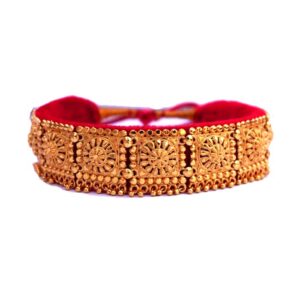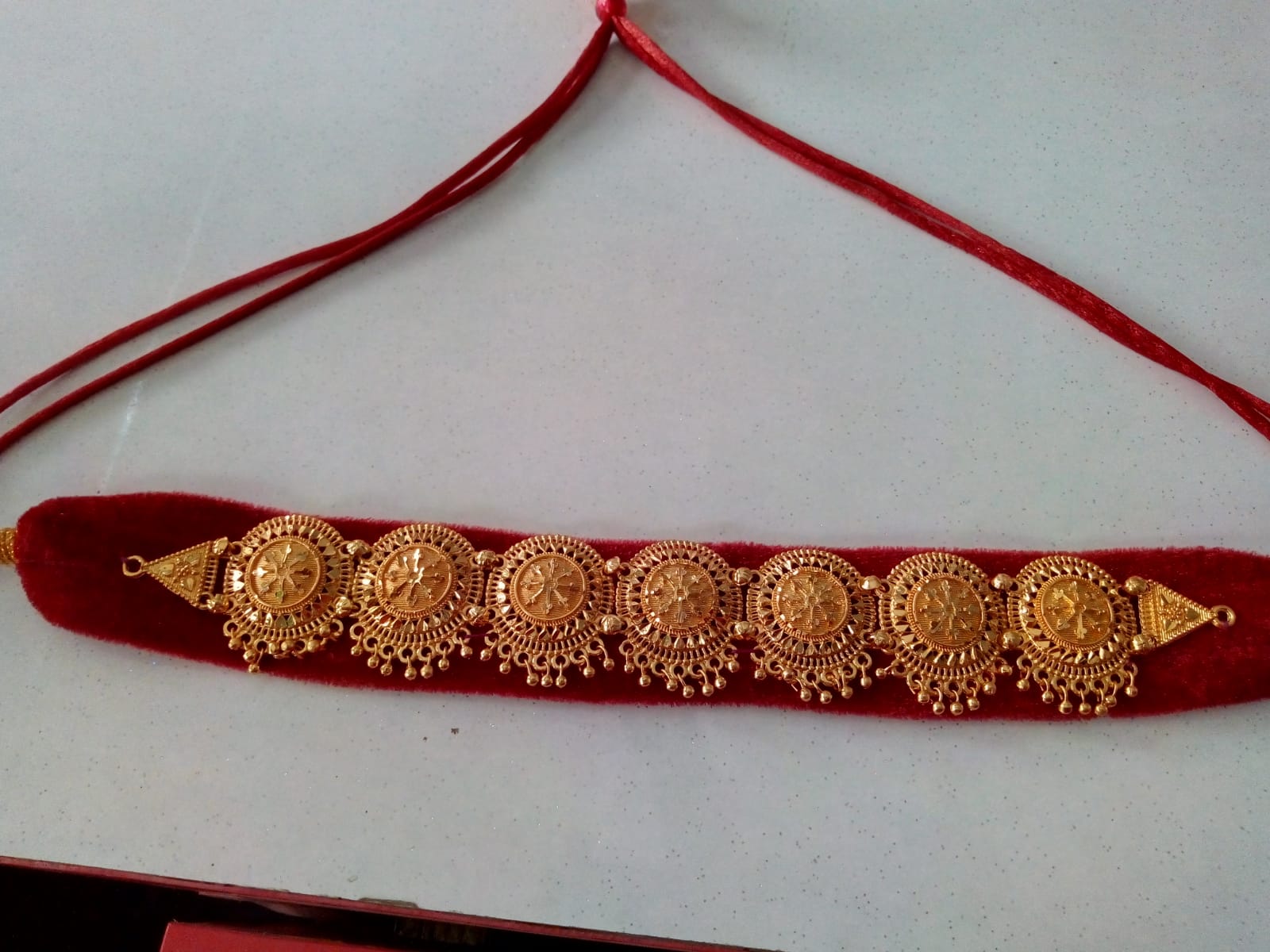Galoband is a traditional necklace from Uttarakhand, worn mostly by married women. It holds deep cultural value for communities like Kumaoni, Garhwali, Bhotiya, and Jaunsari. This distinctive choker reflects the heritage and identity of the people from the region, making it a symbol of their customs and celebrations.
Crafted with care, the Guluband showcases fine workmanship passed down through generations. Its design is both simple and elegant, combining gold or gold-polish materials with intricate detailing. This jewellery piece is not just an ornament but also a mark of respect and pride during festivals and weddings.
Today, guluband necklace continues to be an important sign of tradition in Uttarakhand. It connects the past with the present by keeping the culture alive through its timeless style and significance.
Key Takeaways
- Galoband is a key cultural symbol for married women in Uttarakhand.
- It features detailed craftsmanship that highlights local artistic skills.
- The necklace remains popular in modern times for special occasions and festivals.
Galoband Necklace: Historical Significance
The Galoband holds a strong place in Uttarakhand‘s heritage, symbolizing the region’s deep-rooted traditions and craftsmanship. It connects the past with cultural identity and plays a key role in important social events.
Origins and Evolution
The Guluband is believed to have originated centuries ago in the Kumaon region of Uttarakhand. It started as a simple necklace made from local materials. Over time, it evolved into a gold choker-style ornament, showcasing skilled metalwork and detailed designs.
Its design reflects the influence of local artisans who blended functionality with style. The Galoband’s transformation from basic materials to precious metals like gold marks its rise in cultural and social prominence. This evolution highlights the craftsmanship that defines traditional Kumaoni jewellery.
Cultural Importance in Uttarakhand
In Uttarakhand, the Galoband represents more than just jewellery. It is a symbol of pride and identity for Kumaoni people. Wearing the Galoband reflects a connection to ancestral customs and regional heritage.
The necklace is often passed down through generations, carrying stories and memories. It also signals social status, especially among women, and serves as a mark of respect for tradition. The Galoband’s distinct design helps preserve Kumaoni cultural values and artistic expression.
Role in Traditional Celebrations
The Galoband plays a vital role in weddings and festivals across Kumaon. It is a key part of bridal attire, symbolizing marital status and prosperity. The bride typically wears the Galoband as a focal jewellery piece during wedding ceremonies.
During cultural festivals, the Galoband is worn to honor local customs and religious practices. It is often paired with other traditional ornaments, enhancing the beauty and significance of the occasion. Through its use in celebrations, the Galoband remains a living emblem of Kumaoni tradition.
Design and Craftsmanship
The Galoband showcases skilled handiwork rooted in tradition. Its design reflects the cultural identity of Uttarakhand through the careful selection of materials and unique patterns. The craftsmanship highlights the heritage of the region, blending function with beauty.

Materials and Techniques
Galoband is mainly crafted using gold or silver, often sourced locally in Uttarakhand. Sometimes, brass and other metals are used for more affordable versions. Artisans select these materials for their durability and luster.
The jewellery is handcrafted by skilled local artisans. Techniques include intricate bead weaving, metal engraving, and stone setting. Colorful beads or stones may be woven into the design to add detail.
Silk or cotton threads are sometimes used to bind metal elements, especially in choker-style pieces. Handmade methods ensure every piece has a unique character.
Notable Design Patterns
The Galoband often features floral and geometric patterns. These motifs hold cultural importance and are passed down through generations. Patterns may include repeated shapes or symmetrical designs.
Symbolism plays a role in the motifs, with some patterns representing nature or local beliefs. For example, floral prints can signify growth and beauty. The use of red and white stones or beads is common.
Artisans focus on balance and harmony in their designs. This careful planning creates elegant yet sturdy jewellery suited for both daily wear and special occasions.
Distinguishing Features
One key feature of the Galoband is its choker style, fitting closely around the neck. It typically combines delicate chains or strands with solid metal parts.
The necklace often includes a central pendant or cluster of beads enhancing its visual focus. Red stones, beads, or enamel work are signature elements adding color and contrast.
Handcrafted details like fine engraving or tiny beadwork distinguish authentic pieces. These features make it clear that the Galoband is not just jewellery but a cultural artifact.
Symbolism and Meaning
The Galoband holds a special place in Kumaoni culture. It is more than just a piece of jewellery. Its design and use tell stories of history, community values, and social roles.
Representation of Heritage
The Galoband symbolizes Kumaoni heritage. Its craftsmanship reflects local traditions passed down through generations. Made mainly of gold, it showcases the skill of regional artisans.
This necklace also acts as a visible link to the past. Wearing it keeps Kumaoni history alive. The detailed patterns often include motifs inspired by nature and local myths, showing respect for the environment and ancient beliefs.
The Galoband’s presence during festivals and ceremonies highlights cultural pride. It connects people to their roots and acts as a marker of regional identity.
Social and Marital Significance
The Galoband carries important social meanings. It is traditionally worn by married women, signifying marital status and commitment. This is similar to other pieces like the Nath (nose ring), which also mark marriage in Kumaoni culture.
Beyond marriage, the Galoband indicates social standing. The quality and design can show wealth and family pride. It is often part of bridal jewelry collections and passed down as an heirloom.
By wearing the Galoband, women express their role in family and society. It acts as a symbol of respect, stability, and connection within the community.
Galoband in Modern Times
The Galoband remains a significant piece of Uttarakhand’s cultural heritage while adapting to modern styles and demands. Its designs now blend traditional patterns with contemporary materials and fashion trends, making it relevant in both everyday wear and special occasions.
Contemporary Adaptations
Modern Galobands often use lighter metals and mixed materials like brass and gold plating instead of pure gold or silver. This change makes the jewellery more affordable and easier to wear for longer periods.
Designers introduce simpler shapes and smaller sizes. These adjustments allow the jewellery to be paired with both ethnic and western outfits. Some Galobands now include velvet chokers or colorful threads to add a modern touch without losing the traditional look.
The craftsmanship still honors traditional Kumaoni and Garhwali patterns, but with new finishes and embellishments. This keeps the Galoband attractive to younger generations while preserving its cultural roots.
Influence on Fashion Trends
The Galoband has inspired broader fashion choices in Uttarakhand and beyond. Its distinctive style shapes the way designers create ethnic-inspired accessories and clothing.
Fashion shows and local markets increasingly feature Galoband-inspired items. This popularity sends a message that traditional jewellery can fit into modern wardrobes.
Both men and women show renewed interest in wearing Galoband jewellery. It is no longer limited to ceremonies but is seen as a stylish accessory for everyday use.
The Galoband’s influence also extends to other parts of India, highlighting the craftsmanship of Uttarakhand artisans at national and international levels.
Conclusion
The Galoband stands as a powerful symbol of Uttarakhand’s cultural heritage. It reflects the region’s skill in goldsmith craftsmanship and holds deep meaning in Kumaoni tradition.
This gold choker necklace is more than a piece of jewellery. It signifies marital status and social identity, especially among married women. The Galoband’s design is simple yet elegant, showing the balance between beauty and tradition.
Its presence in weddings and festivals highlights its importance in local customs. Wearing a Galoband connects individuals to their roots and community.
In summary, the Galoband is an essential part of Uttarakhand’s traditional jewellery collection. It blends art, culture, and meaning into a single adornment that continues to be valued today.

